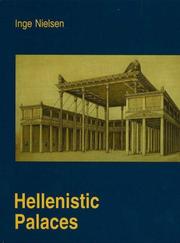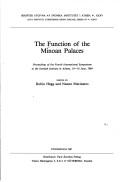| Listing 1 - 10 of 10 |
Sort by
|

ISBN: 8772886455 9788772886459 Year: 1999 Volume: 5 Publisher: Aarhus Aarhus university press
Abstract | Keywords | Export | Availability | Bookmark
 Loading...
Loading...Choose an application
- Reference Manager
- EndNote
- RefWorks (Direct export to RefWorks)
Hellenism --- Palaces --- Architecture, Hellenistic --- Palaces - Greece
Book
ISBN: 2731201452 9782731201451 Year: 1983 Volume: 8 Publisher: Paris : Éditions Atlas,
Abstract | Keywords | Export | Availability | Bookmark
 Loading...
Loading...Choose an application
- Reference Manager
- EndNote
- RefWorks (Direct export to RefWorks)
Crète (Grèce) --- Crete (Greece) --- Antiquités --- Antiquities --- Palaces --- Crète (Grèce) --- Antiquités --- Palaces - Greece - Crete --- Crete (Greece) - Antiquities
Book
ISBN: 0691002169 9780691002163 Year: 1987 Publisher: Princeton (N.J.): Princeton university press
Abstract | Keywords | Export | Availability | Bookmark
 Loading...
Loading...Choose an application
- Reference Manager
- EndNote
- RefWorks (Direct export to RefWorks)
Palaces --- Architecture, Minoan --- Crete (Greece) --- Greece --- Antiquities --- Minoan architecture --- Buildings --- Antiquities. --- Palaces - Greece - Crete --- Architecture, Minoan - Greece - Crete --- Crete (Greece) - Antiquities --- Greece - Antiquities
Book
ISBN: 9783700177913 3700177917 Year: 2015 Volume: 487 34 Publisher: Wien : Verlag der Österreichischen Akademie der Wissenschaften,
Abstract | Keywords | Export | Availability | Bookmark
 Loading...
Loading...Choose an application
- Reference Manager
- EndNote
- RefWorks (Direct export to RefWorks)
Social justice --- Cross-cultural studies. --- Palaces --- Inscriptions, Linear B. --- Religious aspects. --- Greece --- Economic conditions. --- Conferences - Meetings --- Social justice - Greece - Religious aspects. --- Palaces - Greece. --- Greece - Economic conditions.
Book
ISBN: 9780904887709 0904887707 Year: 2019 Volume: 48 Publisher: London : British School at Athens,
Abstract | Keywords | Export | Availability | Bookmark
 Loading...
Loading...Choose an application
- Reference Manager
- EndNote
- RefWorks (Direct export to RefWorks)
Book
ISSN: 07763808 ISBN: 9789042930070 9042930071 Year: 2013 Volume: 35 Publisher: Leuven Liège Peeters
Abstract | Keywords | Export | Availability | Bookmark
 Loading...
Loading...Choose an application
- Reference Manager
- EndNote
- RefWorks (Direct export to RefWorks)
L'architecture crétoise néopalatiale (XVIIe-XVe s. av. J.-C.) est étudiée selon une approche énergétique qui permet de déterminer le temps nécessaire à la construction d'un édifice. Le nombre total d'heures de travail dévolues à l'accomplissement des différentes tâches sur le chantier, depuis l'acquisition des matériaux jusqu'à leur mise en place, est estimé. L'approche permet d’appréhender les comportements des bâtisseurs tels qu'ils se révèlent dans le choix et l'utilisation de matériaux distincts ou dans les travaux d'aménagement du terrain préalables à l'érection du bâtiment. Les résultats de l'application de l'approche énergétique à une sélection d'édifices illustrent la participation des habitants à la construction de leur propre maison, à la différence de la main-d'œuvre abondante et en partie spécialisée impliquée dans la construction de bâtiments aux traits architecturaux élaborés. La diversité des résultats obtenus suggère l'accès ouvert à la main-d'œuvre spécialisée, à laquelle l'élite néopalatiale disposait d'un accès certes privilégié, mais non pas exclusif
Architecture [Minoan ] --- Architecture minoenne --- Architectuur [Minoische ] --- Palaces --- Minoans. --- Excavations (Archaeology) --- Palais --- Minoens --- Fouilles (Archéologie) --- Crete (Greece) --- Crète (Grèce) --- Antiquities. --- Antiquités --- Fouilles (Archéologie) --- Crète (Grèce) --- Antiquités --- Minoans --- Antiquities --- Palaces - Greece - Crete --- Excavations (Archaeology) - Greece - Crete --- Crete (Greece) - Antiquities
Book
ISBN: 9781789254259 1789254256 Year: 2020 Publisher: Oxford : Oxbow books,
Abstract | Keywords | Export | Availability | Bookmark
 Loading...
Loading...Choose an application
- Reference Manager
- EndNote
- RefWorks (Direct export to RefWorks)
"The years c. 1250 to 1150 BC in Greece and the Aegean are often characterised as a time of crisis and collapse. A critical period in the long history of the region and its people and culture, they witnessed the end of the Mycenaean kingdoms, with their palaces and Linear B records, and, through the Postpalatial period, the transition into the Early Iron Age. But, on closer examination, it has become increasingly clear that the period as a whole, across the region, defies simple characterisation - there was success and splendour, resilience and continuity, and novelty and innovation, actively driven by the people of these lands through this transformative century. The story of the Aegean at this time has frequently been incorporated into narratives focused on the wider eastern Mediterranean, and most infamously the 'Sea Peoples' of the Egyptian texts. In twenty-four chapters written by specialists, Collapse and Transformation instead offers a tight focus on the Aegean itself, providing an up-to date picture of the archaeology 'before' and 'after' 'the collapse' of c. 1200 BC. It will be essential reading for students and scholars of the Aegean and eastern Mediterranean regions, as well as providing data and a range of interpretations to those studying collapse and resilience more widely and engaging in comparative studies. Introductory chapters discuss notions of collapse and provide an overview the Mycenaean collapse. These are followed by twelve chapters, which review the evidence from the major regions of the Aegean, including the Argolid, Messenia, and Boeotia, Crete, and the Aegean islands. Six chapters then address key themes: the economy, funerary practices, the Mycenaean pottery of the mainland and the wider Aegean and eastern Mediterranean region, religion, and the extent to which later Greek myth can be drawn upon as evidence or taken to reflect any historical reality. The final four chapters provide a wider context for the Aegean story, surveying the eastern Mediterranean, including Cyprus and the Levant, and the themes of subsistence and warfare"--
Civilization, Mycenaean --- Bronze age --- Palaces --- Inscriptions, Linear B --- Greece --- Economic conditions --- Politics and government --- Linear B inscriptions --- Minoan writing --- Greek language --- Inscriptions, Greek --- Inscriptions, Hieroglyphic --- Mycenaean civilization --- Civilization, Aegean --- Alphabet --- Bronze age - Greece --- Palaces - Greece --- Greece - Economic conditions - To 146 B.C. --- Greece - Politics and government - To 146 B.C.
Book
ISBN: 3805349637 9783805349635 Year: 2017 Publisher: Darmstadt : Verlag Philipp von Zabern, ein Imprint der WBG (Wissenschaftliche Buchgesellschaft),
Abstract | Keywords | Export | Availability | Bookmark
 Loading...
Loading...Choose an application
- Reference Manager
- EndNote
- RefWorks (Direct export to RefWorks)
Civilization, Mycenaean --- Architecture, Mycenaean --- Art, Mycenaean --- Palaces - Greece --- Excavations (Archaeology) - Greece --- Mycenae (Extinct city) --- Civilization, Mycenaean. --- Architecture, Mycenaean. --- Art, Mycenaean. --- Palaces --- Excavations (Archaeology) --- Civilisation mycénienne. --- Architecture mycénienne. --- Art mycénien. --- Palais --- Mycenaean. --- Antiquities. --- Excavations (Archaeology). --- Palaces. --- Mycenae (Extinct city). --- Greece --- Mycènes (Ville ancienne). --- Grèce --- Greece. --- Antiquités.
Book
ISBN: 9781107107540 9781316227718 9781107514836 1107107547 1107514835 1316227715 1316789284 1316792161 1316792641 1316793125 1316793605 1316795047 Year: 2016 Publisher: New York : Cambridge University Press,
Abstract | Keywords | Export | Availability | Bookmark
 Loading...
Loading...Choose an application
- Reference Manager
- EndNote
- RefWorks (Direct export to RefWorks)
In this book, Kramer-Hajos examines the Euboean Gulf region in Central Greece to explain its flourishing during the post-palatial period. Providing a social and political history of the region in the Late Bronze Age, she focuses on the interactions between this 'provincial' coastal area and the core areas where the Mycenaean palaces were located. Drawing on network and agency theory, two current and highly effective methodologies in prehistoric Mediterranean archaeology, Kramer-Hajos argues that the Euboean Gulf region thrived when it was part of a decentralized coastal and maritime network, and declined when it was incorporated in a highly centralized mainland-looking network. Her research and analysis contributes new insights to our understanding of the mechanics and complexity of the Bronze Age Aegean collapse.
Civilization, Mycenaean --- Civilization, Aegean --- Bronze age --- Excavations (Archaeology) --- Palaces --- Coastal settlements --- Social archaeology --- Coastal archaeology --- History --- Euboea Island Region (Greece) --- Antiquities --- Bronze age - Greece - Euboea Island Region --- Excavations (Archaeology) - Greece - Euboea Island Region --- Palaces - Greece - Euboea Island Region - History - To 1500 --- Coastal settlements - Greece - Euboea Island Region - History - To 1500 --- Social archaeology - Greece - Euboea Island Region --- Coastal archaeology - Greece - Euboea Island Region --- Euboea Island Region (Greece) - Antiquities --- Civilization, Mycenaean. --- Civilization, Aegean. --- Antiquities.

ISBN: 9185086940 9789185086948 Year: 1987 Volume: 35 35 Publisher: Stockholm : Svenska Institutet i Athen,
Abstract | Keywords | Export | Availability | Bookmark
 Loading...
Loading...Choose an application
- Reference Manager
- EndNote
- RefWorks (Direct export to RefWorks)
Palaces --- Minoans --- Crete (Greece) --- Antiquities --- -Palaces --- -Buildings --- Civilization, Minoan --- Civilization, Aegean --- Cretans --- Congresses --- -Antiquities --- -Congresses --- Conferences - Meetings --- -Civilization, Minoan --- Buildings --- Candia (Greece) --- Creta (Greece) --- Girit (Greece) --- Girit Adasi (Greece) --- Kirid (Greece) --- Krit (Greece) --- Kreta (Greece) --- Krētē (Greece) --- Kríti (Greece) --- Nísos Kríti (Greece) --- I Keretim (Greece) --- I Kritim (Greece) --- Periphereia Krētēs (Greece) --- Periféreia Krítis (Greece) --- Region of Crete (Greece) --- Crete --- Palaces - Greece - Crete - Congresses --- Minoans - Congresses --- Crete (Greece) - Antiquities - Congresses
| Listing 1 - 10 of 10 |
Sort by
|

 Search
Search Feedback
Feedback About
About Help
Help News
News